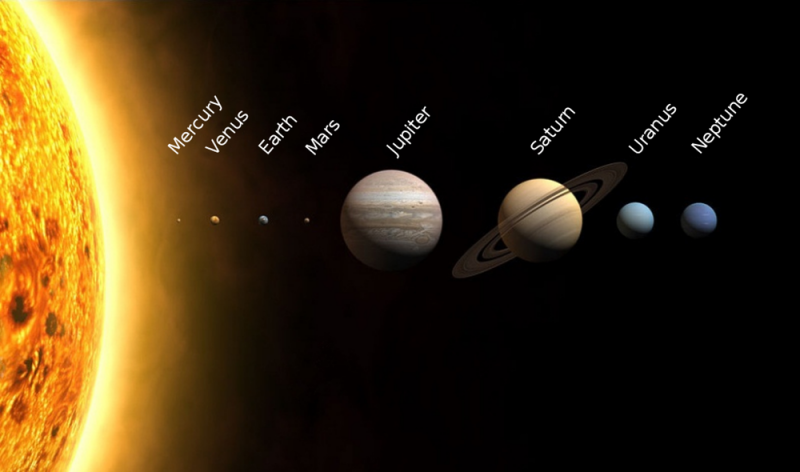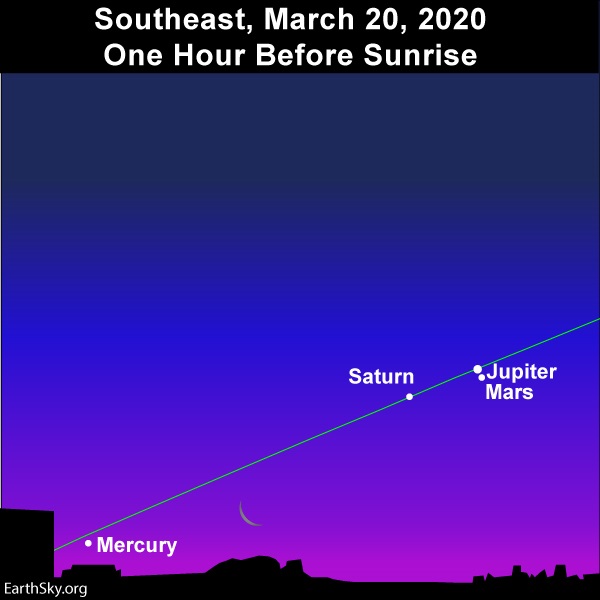
Before dawn on March 16, 2020, the moon will be at or near its half-lit last quarter phase. If you see the moon before dawn, you’ll find its lit side pointing directly toward Jupiter, Mars and Saturn. Then – as the predawn darkness gives way to morning dawn – watch for a fourth morning planet, Mercury, to climb above your sunrise horizon.
Jupiter is by far the brightest of these four worlds, beaming some 11 times brighter than Mercury, 12 times brighter than golden-colored Saturn and 15 times brighter than ruddy Mars. Nonetheless, Mercury, Mars and Saturn are all respectably bright, shining at 1st-magnitude brightness. Mercury, the innermost planet of the solar system, is actually a bit brighter than either Mars or Saturn, but Mercury’s luster will be tarnished by the fact that you’ll see it only in morning twilight.
The coming twilight will be your biggest challenge in catching Mercury. By the time the Mercury rises into your sky, Mars and Saturn might have faded from view, while the much-brighter moon and bright Jupiter will likely still be visible. If so, an imaginary line from the moon through Jupiter will point to Mercury’s spot near the sunrise horizon. Still can’t see it? Try binoculars.
Mercury is more easily viewed with the eye alone from the Southern Hemisphere and the northern tropics this month than at mid-northern latitudes. That’s because – around the time of the March equinox – the ecliptic, or path of the sun, moon and planets, makes a nearly perpendicular angle with the eastern horizon before sunup, as viewed from the Southern Hemisphere.
We give the approximate rising times for Mercury at various latitudes for the next several days (presuming a level horizon):
60 degrees north latitude:
Mercury rises about 1/3 hour before the sun35 degrees north latitude:
Mercury rises about 1 1/6 hours before the sunEquator (0 degrees latitude)
Mercury rises about 1 2/3 hours before the sun35 degrees south latitude
Mercury rises over 2 hours before the sun
The good news is that Mercury will brighten by the day, and will reach its greatest elongation from the sun on March 24, 2020. So – from about mid-March until then – Mercury will rise a bit earlier daily. The southerly latitudes will still enjoy the better view of Mercury, though; from there, Mercury will rise before dawn’s first light. We at northerly latitudes must be content to view Mercury in the glow of dawn.

The planets of the solar system scaled to size but not distance. Mars is about 1 1/2 times the Earth’s distance from the sun, whereas Jupiter and Saturn reside about 5 and 10 times the Earth’s distance from the sun, respectively.
Be aware that the illuminated side of a waning moon points in the moon’s direction of travel in its orbit around Earth. Relative to the stars of the zodiac, the moon moves eastward at about 1/2 degree (its own angular diameter) per hour. In one day, or 24 hours, the moon goes about 13 degrees eastward in front of the constellations of the zodiac. So, in the the week ahead, watch for the moon to pass all four morning planets.

On the mornings of March 17, 18, 19 and 20, 2020, watch for the waning crescent moon to sweep by all 4 morning planets.
The planets Mercury, Mars, Jupiter and Saturn are also traveling eastward in front of the constellations of the zodiac, but at a much slower pace than the moon does. Mercury is the swiftest-moving planet of the solar system, because it’s the closest planet to the sun. But of the three bright planets that orbit the sun outside of Earth’s orbit – Mars, Jupiter, and Saturn – Mars moves the fastest. In contrast to Mars, the planets Jupiter and Saturn move at a snail’s pace.
For the remainder of this month, watch for yourself as Mars speeds along the great race track of the ecliptic, which is Earth’s orbital plane projected onto the dome of the sky. The red planet sweeps to the south of Jupiter on March 20, and then to the south of Saturn by the month’s end. By the way, the green line on our sky charts highlights the ecliptic, which is also the approximate plane of the solar system.

This year, in 2020, the planets Mars and Jupiter are in conjunction at the March 20 equinox.
At present, Mercury is also traveling eastward relative to the backdrop stars, although it’s now traveling westward or away from the sun. Starting on March 24, 2020, Mercury will begin to move eastward again – toward the sunrise – yet will remain in the morning sky (at least nominally) throughout April 2020.
Read more: Jupiter gives us Pluto in 2020
Bottom line: Look outside before dawn on March 16, 2020, for the last quarter moon. Its illuminated side will be pointing at the planets Jupiter, Mars and Saturn. Some people will catch Mercury, too, shortly before sunrise.
from EarthSky https://ift.tt/2Qdccyk

Before dawn on March 16, 2020, the moon will be at or near its half-lit last quarter phase. If you see the moon before dawn, you’ll find its lit side pointing directly toward Jupiter, Mars and Saturn. Then – as the predawn darkness gives way to morning dawn – watch for a fourth morning planet, Mercury, to climb above your sunrise horizon.
Jupiter is by far the brightest of these four worlds, beaming some 11 times brighter than Mercury, 12 times brighter than golden-colored Saturn and 15 times brighter than ruddy Mars. Nonetheless, Mercury, Mars and Saturn are all respectably bright, shining at 1st-magnitude brightness. Mercury, the innermost planet of the solar system, is actually a bit brighter than either Mars or Saturn, but Mercury’s luster will be tarnished by the fact that you’ll see it only in morning twilight.
The coming twilight will be your biggest challenge in catching Mercury. By the time the Mercury rises into your sky, Mars and Saturn might have faded from view, while the much-brighter moon and bright Jupiter will likely still be visible. If so, an imaginary line from the moon through Jupiter will point to Mercury’s spot near the sunrise horizon. Still can’t see it? Try binoculars.
Mercury is more easily viewed with the eye alone from the Southern Hemisphere and the northern tropics this month than at mid-northern latitudes. That’s because – around the time of the March equinox – the ecliptic, or path of the sun, moon and planets, makes a nearly perpendicular angle with the eastern horizon before sunup, as viewed from the Southern Hemisphere.
We give the approximate rising times for Mercury at various latitudes for the next several days (presuming a level horizon):
60 degrees north latitude:
Mercury rises about 1/3 hour before the sun35 degrees north latitude:
Mercury rises about 1 1/6 hours before the sunEquator (0 degrees latitude)
Mercury rises about 1 2/3 hours before the sun35 degrees south latitude
Mercury rises over 2 hours before the sun
The good news is that Mercury will brighten by the day, and will reach its greatest elongation from the sun on March 24, 2020. So – from about mid-March until then – Mercury will rise a bit earlier daily. The southerly latitudes will still enjoy the better view of Mercury, though; from there, Mercury will rise before dawn’s first light. We at northerly latitudes must be content to view Mercury in the glow of dawn.

The planets of the solar system scaled to size but not distance. Mars is about 1 1/2 times the Earth’s distance from the sun, whereas Jupiter and Saturn reside about 5 and 10 times the Earth’s distance from the sun, respectively.
Be aware that the illuminated side of a waning moon points in the moon’s direction of travel in its orbit around Earth. Relative to the stars of the zodiac, the moon moves eastward at about 1/2 degree (its own angular diameter) per hour. In one day, or 24 hours, the moon goes about 13 degrees eastward in front of the constellations of the zodiac. So, in the the week ahead, watch for the moon to pass all four morning planets.

On the mornings of March 17, 18, 19 and 20, 2020, watch for the waning crescent moon to sweep by all 4 morning planets.
The planets Mercury, Mars, Jupiter and Saturn are also traveling eastward in front of the constellations of the zodiac, but at a much slower pace than the moon does. Mercury is the swiftest-moving planet of the solar system, because it’s the closest planet to the sun. But of the three bright planets that orbit the sun outside of Earth’s orbit – Mars, Jupiter, and Saturn – Mars moves the fastest. In contrast to Mars, the planets Jupiter and Saturn move at a snail’s pace.
For the remainder of this month, watch for yourself as Mars speeds along the great race track of the ecliptic, which is Earth’s orbital plane projected onto the dome of the sky. The red planet sweeps to the south of Jupiter on March 20, and then to the south of Saturn by the month’s end. By the way, the green line on our sky charts highlights the ecliptic, which is also the approximate plane of the solar system.

This year, in 2020, the planets Mars and Jupiter are in conjunction at the March 20 equinox.
At present, Mercury is also traveling eastward relative to the backdrop stars, although it’s now traveling westward or away from the sun. Starting on March 24, 2020, Mercury will begin to move eastward again – toward the sunrise – yet will remain in the morning sky (at least nominally) throughout April 2020.
Read more: Jupiter gives us Pluto in 2020
Bottom line: Look outside before dawn on March 16, 2020, for the last quarter moon. Its illuminated side will be pointing at the planets Jupiter, Mars and Saturn. Some people will catch Mercury, too, shortly before sunrise.
from EarthSky https://ift.tt/2Qdccyk

Aucun commentaire:
Enregistrer un commentaire